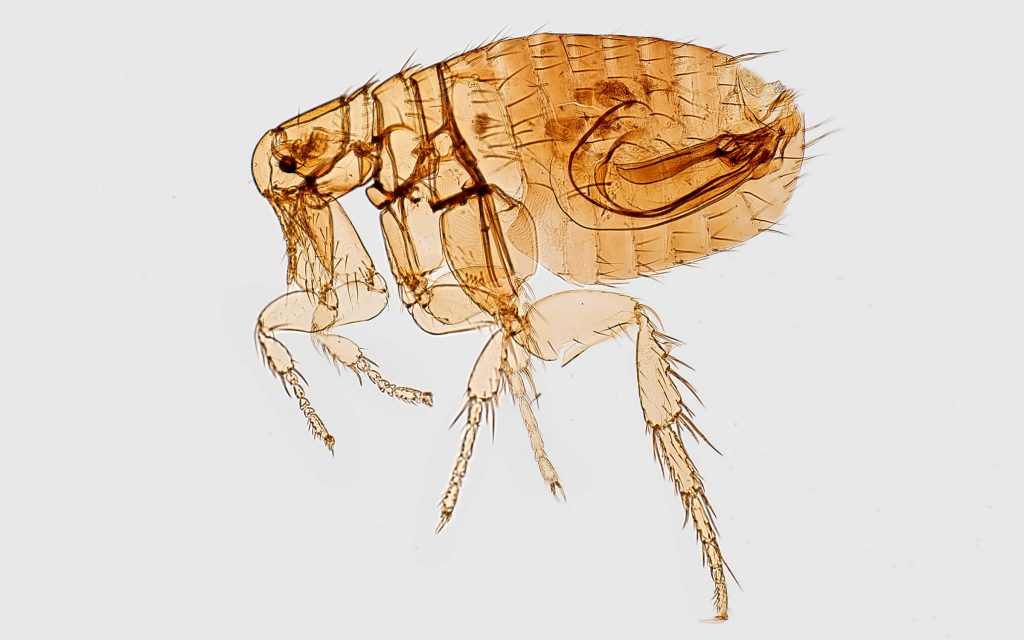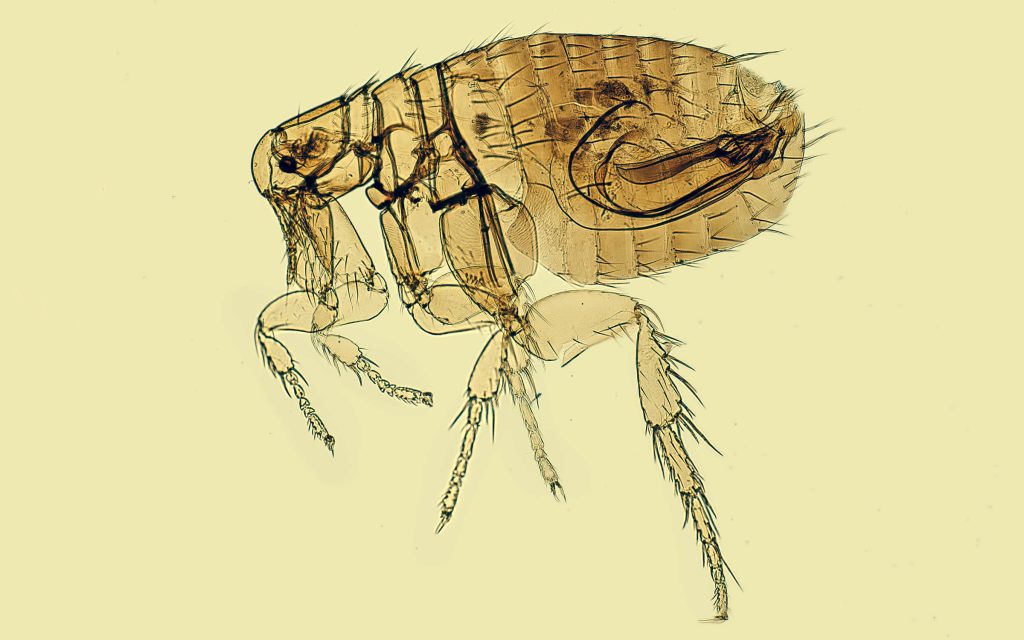Fleas
A pet loving country like Australia combined with a warm climate makes Australia a fleas Paradise. The most common fleas species in Australia are cat fleas(ctenocephalides), dog fleas (canis ctenocephalides), human fleas (pulex irritanis), moorhen fleas (dasypsyllus callinulae), northern rat fleas (nosopsyllus fasciatus)and lets not forget about the oriental flea (xenopsylla cheopis).
Identifying fleas: a Sydney resident’s guide.
Fleas. They’re associated with itching, scratching, and irritation, and any Sydney pet owner is loath to consider the idea of a flea infestation. I was conducting a termite control treatment in a sub-floor of a house in Epping two years back and had to have a weeks sick leave because I had over 100 flea bites over my body. Unfortunately, fleas don’t just affect pets, but pose a problem to humans as well. So what are fleas and how can they be managed?
What are fleas? Fleas are minute, reddish-brown insects. They range in size from 2-8mm in length, and although visible to the naked eye, they can be extremely difficult to spot. Their body is “flat” in appearance, a feature that allows them to move with ease. Fleas drink blood for survival, and their bite may cause irritation and itching in their victims. Fleas live for up to eight months, and female fleas may lay up to one hundred eggs during their life time. Where does the flea live? Because fleas typically feed on animal blood, they are often found around the areas where your pet is most commonly found. These include your pet’s bedding, your pet’s eating area, and your pet’s play area. Fleas, however, are not limited to the home: they can frequently be found in grassy or open areas, such as parks, where dogs often play.
Managing fleas around the home. If you’re a pet owner, taking a proactive stance when it comes to managing fleas is essential. If you suspect a flea infestation, calling in a licensed pest controller may be the best and most thorough way to deal with your flea issues, but you can take some basic steps towards flea control first. These include mowing your lawn and trimming back any overgrown areas of your garden or backyard; vacuuming your floors, rugs, and mats; washing any pet bedding or accessories; and keeping the floor areas of your home as tidy as possible. Professional flea control Flea control at the hands of a professional is an involved task, but it’s one that you’ll be thankful for. The process involves using a water-based flea pest control product such as Cislin to treat the external areas of the home as well as the carpets, floorboards and so on found within the property. This process is designed to kill off both adult fleas as well as recently hatched larvae. Because eggs are not affected by the treatment, time must be allowed for larvae to hatch and subsequently become infected by the product. If you’re concerned about a flea infestation in your Sydney home, contact us for more information about managing the issue.
Cat Fleas
Of all the flea species found worldwide, the cat flea is one of the most prevalent. Although typically found on domestic cats, it can also infect dogs, as well as a variety of other mammals. Fortunately, although humans can be bitten by cat fleas, they cannot become a host, meaning that cat fleas will die out within the home if no cat or other animal is present on the property.
Cat fleas: life cycle. Cat fleas lay their eggs on the host animal, after which the eggs make their way in to the animal’s bedding or shelter, where they hatch and go through a number of growth stages before becoming a newly hatched flea. The newly hatched flea jumps on to a host as soon as one is deemed present, and within a few minutes will be feasting on the new host.
Cat fleas: their effects. Cat fleas may be little more than a minor nuisance to a host unless the animal develops an intolerance or allergy to the flea. In some animals, a flea infestation may result in dermatitis, a condition where the skin becomes inflamed and irritated. A severe flea infestation may also cause problems for very small animals, as they may become dehydrated and weak over time. In some cases, fleas might also transmit diseases from the host to other animals, and even to humans.
Managing cat fleas at their source. Cat fleas can be managed using a variety of specific products, although these products may vary in their effectiveness. Flea collars are a popular choice for keeping cat fleas at bay, and flea shampoos may also be effective. Flea combs and powders may offer some protection, but tend not to be highly effective. Some topical products may also be beneficial .
Managing cat fleas around the home. Some commercial aerosol-based products can be effective in helping to kill larvae or prevent flea eggs from hatching, while regular vacuuming and washing can help to rid the home of cat fleas and their eggs. Because fleas often hide in out-of-the-way areas, special attention should be paid to corners, dark places, and beneath furniture. Treating your backyard and garden can also be an effective way of keeping fleas at bay. If you’re concerned about cat fleas, you can also speak to a qualified pest controller about how to manage your problem. For more information, contact our friendly team today.
Dog Fleas
Dog fleas are a variety of flea most commonly found on dogs. However, if you’re a dog-owner, you’ll be all too aware that dog fleas can also bite humans. Dog fleas can be problematic, because not only are they long-lived, but they can go without food for months, and lay thousands of eggs, resulting in widespread and ingrained infestations.
The appearance of the dog flea Dog fleas live on the fur or skin of your pet, and live off blood as their sole food source. They are small in size, and feature a flattened body. Although they do not have wings, they can jump long distances, and can easily travel along a dog’s coat.
The symptoms of a dog flea infestation A dog flea infestation is no picnic for your pet. Dog fleas can cause itching and discomfort in minor cases, but in more severe cases can cause severe skin problems that may lead to infection. In extreme cases, some dogs may become anemic from a dog flea infestation; and the transmission of diseases and parasites such as tapeworms isn’t unknown. Humans who are bitten by dog fleas may find that the affected area itches and may bleed. Flea bites typically occur in protected areas around the joints, including ankles and knees.
Treating a dog flea infestation Although dog fleas primarily reside on dogs, it’s essential to treat not only your pet, but their bedding, their play areas, and other areas around your home. The use of topical flea products can be effective in treating and preventing flea infestations, but to be truly effective a more wide-reaching regimen needs to be implemented. Vacuuming areas such as bedding, carpets, and curtains can help remove flea eggs from the home, and mowing lawns and clearing up outdoor play areas can also help.
Flea control experts Because flea control is typically an ongoing process, employing the services of an expert pest control professional can be effective in not only removing fleas, but in helping stave off their return in the longer-term. For more information about how to manage dog fleas in your home, contact us today.
Human Fleas
The very thought of human fleas is one that induces discomfort. The human flea is thought to have originally come from South America, perhaps transmitted originally by a peccary or guinea pig. Despite its name, the human flea also affects a variety of other mammals, including dogs, monkeys, cats, and rodents. Birds can also be affected by the human flea.
Fleas and their symptoms .Although human fleas are relatively uncommon, they can cause a number of problems in human hosts. These include itching and irritation, and even the transmission of diseases. The human flea is thought to have played a role in the transmission of the famous bubonic plague, for example. Human fleas may also transmit diseases such as typhus, or parasites such as tapeworms. Most common, however, are infections or allergic reactions such as dermatitis, which can cause a good deal of discomfort for the host.
The appearance of the human flea. There are many different types of fleas, but all have similar characteristics: they are small, flat in appearance, and wingless. They are capable of jumping great distances, and are skilled at climbing across hair and fur. Larval fleas look quite different from adult fleas, and may resemble caterpillars or worms in appearance. They are eyeless and legless.
Fleas and feeding. Fleas progress through a number of different stages after hatching, but it is only during the adult stage that the flea feeds on the blood of its host. They do this by piercing the skin using their mouth parts and then extracting the blood. Larval fleas, in contrast, feed on dust and shed skin cells, and are often found in bedding.
Managing human fleas. As with any variety of fleas, properly managing human fleas can be quite an involved process. Not only must the adult fleas be managed, but fleas at all other stages of the life cycle, including larvae and eggs, must be dealt with. This means that concerted efforts must be made to clean and treat a variety of areas, including bedding, furniture, carpets, and outdoor areas. Because fleas can live months without feeding, management processes must be persistent and thorough. For more information about managing human fleas, or any other variety of flea in your home, contact us today.


